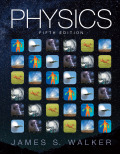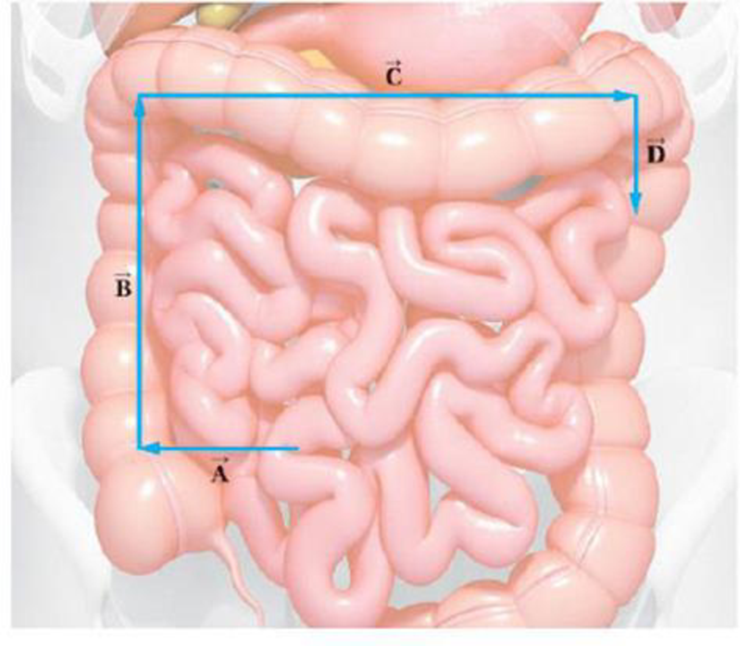Problem 1CQ: For the following quantities, indicate which is a scalar and which is a vector: (a) the time it... Problem 2CQ: Which, if any of the vectors shown in Figure 3-36 are equal? FIGURE 3-36 Conceptual Question 2 Problem 3CQ: Given that A+B=0, (a) how does the magnitude of B compare with the magnitude of A? (b) How does the... Problem 4CQ: Can a component of a vector be greater than the vectors magnitude? Problem 5CQ Problem 6CQ: Can a vector with zero magnitude heve one or more components that are nonzero? Explain. Problem 7CQ Problem 8CQ Problem 9CQ Problem 10CQ Problem 11CQ Problem 12CQ: Use a sketch to show that two vectors of unequal magnitude cannot add to zero, but that three... Problem 13CQ: Rain is falling vertically downward and you are running for shelter. To keep driest. should you hold... Problem 14CQ: When sailing, the wind feels stronger when you sail upwind (beating) than when you are sailing... Problem 1PCE: Suppose that each component ot a certain vector is doubled. (a) By what multiplicative (actor does... Problem 2PCE: Rank the vectors in Figure 3-37 in order of increasing magnitude. Figure 3-37 Problems 2, 3, and 4 Problem 3PCE: Rank the vectors in Figure 3-37 in order of increasing value of their X component. Problem 4PCE: Rank the vectors in Figure 3-37 in order of increasing value of their y component Problem 5PCE: The press box at a baseball park is 44.5 ft above the ground. A reporter in the press box looks at... Problem 6PCE: You are driving up a long, inclined road. After 1.2 miles you notice that signs along the roadside... Problem 7PCE: A One-Percent Grade A road that rises 1 ft for every 100 ft traveled horizontally is said to have a... Problem 8PCE: You walk in a straight line tor 95 m at an angle of 162 above the positive x axis. What are the x... Problem 9PCE: Find the x and y components of a position vector r of magnitude r = 88 m, if its angle relative to... Problem 10PCE: A vector has the components Az = 22 m and Ay = 13 m. (a) What is the magnitude of this vector? (b)... Problem 11PCE: A vector has the components Az = 36 m and Ay = 43 m. (a) What is the magnitude of this vector? (b)... Problem 12PCE: A baseball diamond (Figure 3-38) is a square with sides 90 ft in length. If the positive x axis... Problem 13PCE: A lighthouse that rises 49 ft above the surface of the water sits on a rocky cliff that extends 19... Problem 14PCE: H2O A water molecule is shown schematically in Figure 3-40. The distance from the center of the... Problem 15PCE Problem 16PCE: You drive a car 660 ft to the east, then 340 ft to the north. (a) What is the magnitude of your... Problem 17PCE: Vector A has a magnitude of 50 units and points in the positive x direction. A second vector, B, has... Problem 18PCE: A treasure map directs you to start at a palm tree and walk due north for 15.0 m. You are then to... Problem 19PCE: A whale comes to the surface to breathe and then dives at an angle of 20.0 below the horizontal... Problem 20PCE: Consider the vectors A and B shown in Figure 3-42. Which of the other four vectors in the figure (C,... Problem 21PCE: Refer to Figure 3-42 for the following questions (a) Is the magnitude of A+D greater than, less... Problem 22PCE: A vector A has a magnitude of 40.0 m and points in a direction 20.0 below the positive x axis .A... Problem 23PCE: An air traffic controller observes two airplanes approaching the airport. The displacement from the... Problem 24PCE: The initial velocity of a car, vi, is 45 km/h in the positive x direction. The final velocity of the... Problem 25PCE: Vector A points in the positive x direction and has a magnitude of 75 m. The vector C=A+B points in... Problem 26PCE: Vector A points in the negative x direction and has a magnitude of 22 units. The vector B points in... Problem 27PCE: Vector A points in the negative y direction and has a magnitude of 5 units. Vector B has twice the... Problem 28PCE: A basketball player runs down the court, following the path indicated by the vectors A, B, and C in... Problem 29PCE: A particle undergoes a displacement r of magnitude 54 m in a direction 42 below the x axis. Express... Problem 30PCE: A vector has a magnitude of 3.50 m and points in a direction that is 145 counterclockwise from the x... Problem 31PCE: A vector A has a length of 6.1 m and points in the negative x direction. Find (a) the x component... Problem 32PCE: The vector 5 2 A has a magnitude of 34 m and points in the positive x direction. Find (a) the x... Problem 33PCE: Find the direction and magnitude of the vectors. a. A=(5.0m)x+(2.0m)y, b. B=(2.0m)x+(5.0m)y, and (c)... Problem 34PCE: Find the direction and magnitude of the vectors. a. A=(22m)x+(14m)y, b. B=(2.5m)x+(13m)y, and (c)... Problem 35PCE: For the vectors given in Problem 34, express (a) AB and (b) BA in unit vector notation. Problem 36PCE: Express each of the vectors in Figure 3-44 in unit vector notation. Problem 37PCE: Referring to the vectors in Figure 3-44, express the sum A+B+C in unit vector notation. Problem 38PCE: The blue curves shown in Figure 3-45 display the constant-speed motion of two different particles in... Problem 39PCE: What are the direction and magnitude of your total displacement if you have traveled due west with a... Problem 40PCE: Predict/Calculate Moving the Knight Two of the allowed chess moves for a knight are shown in Figure... Problem 41PCE: To visit your favorite ice cream shop, you must travel 490 m west on Main Street and then 950 m... Problem 42PCE: Referring to Problem 41, suppose you lake 44 s to complete the 490-m displacement and 73 s to... Problem 43PCE: You drive a car 1500 ft to the east, then 2500 ft to the north. If the trip took 3.0 minutes, what... Problem 44PCE: Predict/Calculate A jogger runs with a speed of 3.25 m/s in a direction 30.0 above the x axis. (a)... Problem 45PCE: You throw a ball upward with an initial speed of 4.5 m/s. When it returns to your hand 0.92 s later,... Problem 46PCE: Consider a skateboarder who starts from rest at the top of a ramp that is inclined at an angle of... Problem 47PCE: In a soccer game a midfielder kicks the ball from one touchline directly toward the other with a... Problem 48PCE: The accompanying photo shows a KC-10A Extender using a boom to refuel an aircraft in flight. If the... Problem 49PCE: As an airplane taxied on the runway with a speed of 16.5 m/s, a flight attendant walks toward the... Problem 50PCE: Referring to part (a) of Example 3-11, find the time it takes for the boat to reach the opposite... Problem 51PCE: A police car travels at 38.0 m/s due east while in pursuit of a vehicle that is traveling at 33.5... Problem 52PCE: Consider the river crossing problem in Example 3-11. Suppose we would like the boat to move directly... Problem 53PCE: As you hurry to catch your flight at the local airport, you encounter a moving walkway that is 61 m... Problem 54PCE: In Problem 53, how much lime would it take you to cover the 61-m length of the walkway if, once you... Problem 55PCE: Predict/Calculate The pilot of an airplane wishes to fly due north, but there is a 65-km/h wind... Problem 56PCE: A passenger walks from one side of a ferry to the other as it approaches a dock. If the passengers... Problem 57PCE: You are riding on a Jet Ski at an angle of 35 upstream on a river flowing with a speed of 2.8 m/s.... Problem 58PCE: Predict/Calculate In Problem 57, suppose the Jet Ski is moving at a speed of 11 m/s relative to the... Problem 59PCE: Predict/Calculate Two people take identical Jet Skis across a river, traveling at the same speed... Problem 60GP: CE Predict/Explain Consider the vectors A=(1.2m)x and B=(3.4m)x. (a) Is the magnitude of vector A... Problem 61GP: CE Predict/Explain Two vectors are defined as follows A=(3.8m)x and B=(2.1m)y. (a) Is the magnitude... Problem 62GP: To be compliant with regulations the inclination angle of a wheelchair ramp must not exceed 4.76. If... Problem 63GP: Find the direction and magnitude of the vector 2A+B, where A=(12.1m)x and B=(32.2m)y. Problem 64GP Problem 65GP Problem 66GP Problem 67GP: You pilot an airplane with the intent to fly 392 km in a direction 55.0 south of east from the... Problem 68GP: Find the x, y, and z components of the vector A shown in Figure 3-47, given that A = 65 m. Problem 69GP: Observer 1 rides in a car and drops a ball from rest straight downward, relative to the interior of... Problem 70GP: A person riding in a subway train drops a ball from rest straight downward, relative to the interior... Problem 71GP: A football is thrown horizontally with an initial velocity of (16.6m/s)x. ignoring air resistance,... Problem 72GP: As a function of time, the velocity of the football described in Problem 71 can be written as... Problem 73GP: Two airplanes taxi as they approach the terminal. Plane 1 taxies with a speed of 12 m/s due north.... Problem 74GP: A shopper at the supermarket follows the path indicated by vectors A, B, C, and D in Figure 3-48.... Problem 75GP: BIO A food particle from your breakfast takes a circuitous path through your digestive system.... Problem 76GP: Initially a particle is moving at 4.10 m/s at an angle of 33.5 above the horizontal. Two seconds... Problem 77GP: A passenger on a stopped bus notices that rain is falling vertically just outside the window. When... Problem 78GP: Predict/Calculate Suppose we orient the x axis of a two-dimensional coordinate system along the... Problem 79GP: Predict/Calculate The Longitude Problem In 1759, John Harrison (1693-1776) completed his fourth... Problem 80GP: Referring to Example 3-11, (a) what heading must the boat have if it is to land directly across the... Problem 81GP: Vector A points in the negative x direction. Vector B points at an angle of 30.0 above the positive... Problem 82GP: As two boats approach the marina, the velocity of boat 1 relative to boat 2 is 2.15 m/s in a... Problem 83PP: BIO Motion Camouflage in Dragonflies Dragonflies, whose ancestors were once the size of hawks, have... Problem 84PP: BIO Motion Camouflage in Dragonflies Dragonflies, whose ancestors were once the size of hawks, have... Problem 85PP: BIO Motion Camouflage in Dragonflies Dragonflies, whose ancestors were once the size of hawks, have... Problem 86PP: BIO Motion Camouflage in Dragonflies Dragonflies, whose ancestors were once the size of hawks, have... Problem 87PP: BIO Motion Camouflage in Dragonflies Dragonflies, whose ancestors were once the size of hawks, have... Problem 88PP: BIO Motion Camouflage in Dragonflies Dragonflies, whose ancestors were once the size of hawks, have... format_list_bulleted



 Principles of Physics: A Calculus-Based TextPhysicsISBN:9781133104261Author:Raymond A. Serway, John W. JewettPublisher:Cengage Learning
Principles of Physics: A Calculus-Based TextPhysicsISBN:9781133104261Author:Raymond A. Serway, John W. JewettPublisher:Cengage Learning College PhysicsPhysicsISBN:9781938168000Author:Paul Peter Urone, Roger HinrichsPublisher:OpenStax College
College PhysicsPhysicsISBN:9781938168000Author:Paul Peter Urone, Roger HinrichsPublisher:OpenStax College Physics for Scientists and Engineers with Modern ...PhysicsISBN:9781337553292Author:Raymond A. Serway, John W. JewettPublisher:Cengage Learning
Physics for Scientists and Engineers with Modern ...PhysicsISBN:9781337553292Author:Raymond A. Serway, John W. JewettPublisher:Cengage Learning University Physics Volume 1PhysicsISBN:9781938168277Author:William Moebs, Samuel J. Ling, Jeff SannyPublisher:OpenStax - Rice University
University Physics Volume 1PhysicsISBN:9781938168277Author:William Moebs, Samuel J. Ling, Jeff SannyPublisher:OpenStax - Rice University Physics for Scientists and Engineers: Foundations...PhysicsISBN:9781133939146Author:Katz, Debora M.Publisher:Cengage Learning
Physics for Scientists and Engineers: Foundations...PhysicsISBN:9781133939146Author:Katz, Debora M.Publisher:Cengage Learning Glencoe Physics: Principles and Problems, Student...PhysicsISBN:9780078807213Author:Paul W. ZitzewitzPublisher:Glencoe/McGraw-Hill
Glencoe Physics: Principles and Problems, Student...PhysicsISBN:9780078807213Author:Paul W. ZitzewitzPublisher:Glencoe/McGraw-Hill




